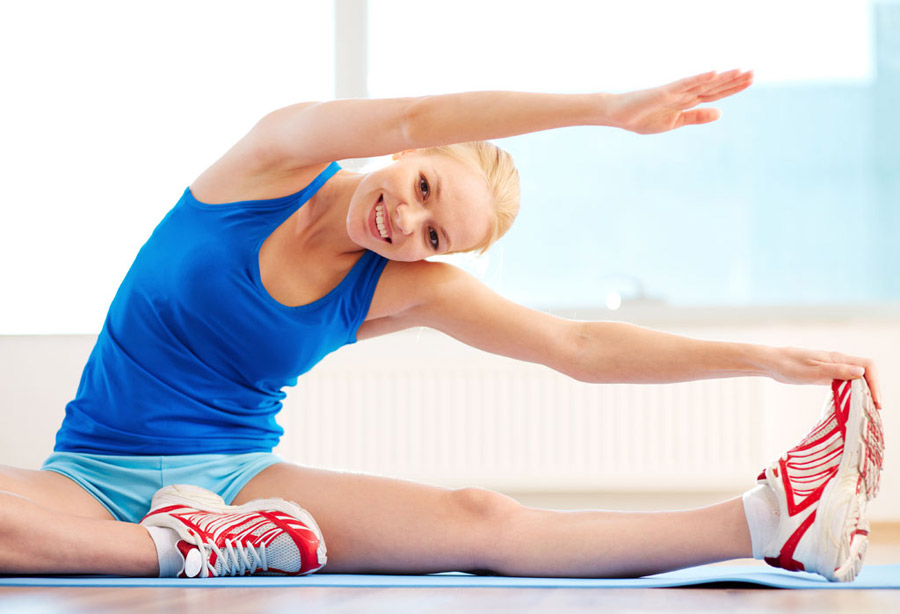- Introduction
- Stretching Techniques
- Benefits of Flexibility Training
- Ballistic Stretching
- PNF Stretching
- Static Stretching
- Use of Static Stretching
- When and Where to Stretch
- The Do's and Don't of proper Stretching
- Stretching During Pregnancy
- What Happens to Muscles and Tendons During a Stretch ?
- Always Warm-Up Before Stretching
- Stretch Before and After Exercise
- Stretch Between Weightlifting Sets
- Stretch Before and After Cardiovascular Exercise
- Importance of Combining Strength Training, Cardiovascular Exercise, and Good Nutrition with Your Flexibility Training Program
- Staying Motivated
- Factors Affecting Flexibility
- Take Action
WF flexibility training component is your on-line "how to"
manual. Everything you need to know about flexibility training and
exactly how to achieve the results you desire, is taught in this
manual.
The flexibility training component is 16 pages long and can be viewed on your computer or printed out. All the examples in this content are linked to demonstrations that will enhance your understanding.
Below is a list of all the very important topics we'll discuss throughout the flexibility training components.
In the flexibility training component, you will find information on:
- The benefits of flexibility training
- The three basic stretching techniques
- Principles and guidelines for:
- Using static stretching to achieve maximum results
- The importance of warming-up before stretching
- Stretching before and after exercise
- The importance of stretching between weightlifting sets
- How and when to include stretching in your strength training program without
taking up more time
- How and when to include stretching in your cardiovascular exercise program for
maximum results
- How to combine strength training, cardiovascular exercise, and good nutrition
into your flexibility training program
- Ways to stay motivated
- The factors that affect your flexibility
- All the examples in this content are linked to demonstrations that will enhance your understanding.
Introduction

The
flexibility Training component will teach you the three basic
stretching techniques and the very important principles and
guidelines of a safe, effective flexibility-training program.
You'll learn exactly how to get the best results, including when
to stretch, how often to stretch, and how long to hold the stretch
for maximum benefits. In addition, you'll learn how to include
stretching with your cardiovascular exercise and strength-training
programs, without taking up much of your valuable time. We also
discuss ways of staying motivated throughout your program. Lastly,
we'll discuss the factors that affect flexibility.
Warming up and cooling down should be an integral part of any type
of exercise or sport, particularly aerobics, for its dangerous and
in efficient to leap immediately from rest to maximum activity.
When you are at rest, your blood circulates more or loss evenly
through the body, facilitating the healthy functioning of all
vital organs. When a specific part of the body is called into
action a greater blood supply carrying oxygen is sent to the
working parts.
Warm up and stretching is essential to signal your body that a
certain group of muscles will be in need of increased supply of
oxygen.
Benefits of Flexibility Training

Flexibility
is a joint's ability to move through a full range of motion.
Flexibility training (stretching) helps balance muscle groups that
might be overused during exercise or physical activity or as a
result of bad posture. It's important to clearly understand the
many benefits that result from a good flexibility program.
Improved Physical Performance and Decreased Risk of Injury
First, a safe and effective flexibility training program increases
physical performance. A flexible joint has the ability to move
through a greater range of motion and requires less energy to do
so, while greatly decreasing your risk of injury. Most
professionals agree that stretching decreases resistance in tissue
structures; you are, therefore, less likely to become injured by
exceeding tissue extensibility (maximum range of tissues) during
activity.
Reduced Muscle Soreness and Improved Posture
Stretching reduces muscle soreness , refer to the Strength
Training content ahead . Recent studies show that slow, static
stretching (explained in the next section) helps reduce muscle
soreness after exercise. Moreover, stretching improves muscular
balance and posture. Many women's soft-tissue structures had
adapted poorly to either the effect of gravity or poor postural
habits. Stretching can help realign soft tissue structures, thus
reducing the effort it takes to achieve and maintain good posture
in the activities of daily living.
Reduced Risk of Low Back Pain
A key benefit, and one we wish more women would realize, is that
stretching reduces the risk of low back pain.
Stretching promotes muscular relaxation. A muscle in constant
contraction requires more energy to accomplish activities.
Flexibility in the hamstrings, hip flexors, quadriceps, and other
muscles attaching to the pelvis reduces stress to the low back.
Stretching causes muscular relaxation, which encourages healthy
nutrition directly to muscles; the resulting reduction in
accumulated toxins reduces the potential for muscle shortening or
tightening and thus reduces fatigue.
Increased Blood and Nutrients to Tissues
Another great benefit is that stretching increases blood supply
and nutrients to joint structures. Stretching increases tissue
temperature, which in turn increases circulation and nutrient
transport. This allows greater elasticity of surrounding tissues
and increases performance. Stretching also increases joint
synovial fluid, which is a lubricating fluid that promotes the
transport of more nutrients to the joints' articular cartilage.
This allows a greater range of motion and reduces joint
degeneration.
Improved Muscle Coordination
Another little-known benefit is increased neuromuscular
coordination. Studies show that nerve-impulse velocity (the time
it takes an impulse to travel to the brain and back) is improved
with stretching. This helps opposing muscle groups work in more
synergistic, coordinated fashion.
Enhanced Enjoyment of Physical Activities

Flexibility training also means enhanced enjoyment, and a fitness program should be fun if you want to stick with it. Not only does stretching decrease muscle soreness and increase performance; it also helps relax both mind and body and brings a heightened sense of well being and personal gratification during exercise.
You are now ready for the Flexibility Training component. We begin with the stretching techniques, and then proceed to the principles and guidelines of an effective flexibility-training program. We will then discuss the best ways to stay motivated and the factors that effect flexibility.
Three basic techniques are used to increase flexibility: ballistic stretching, pro-prioceptive neuromuscular facilitation (PNF) and static stretching.